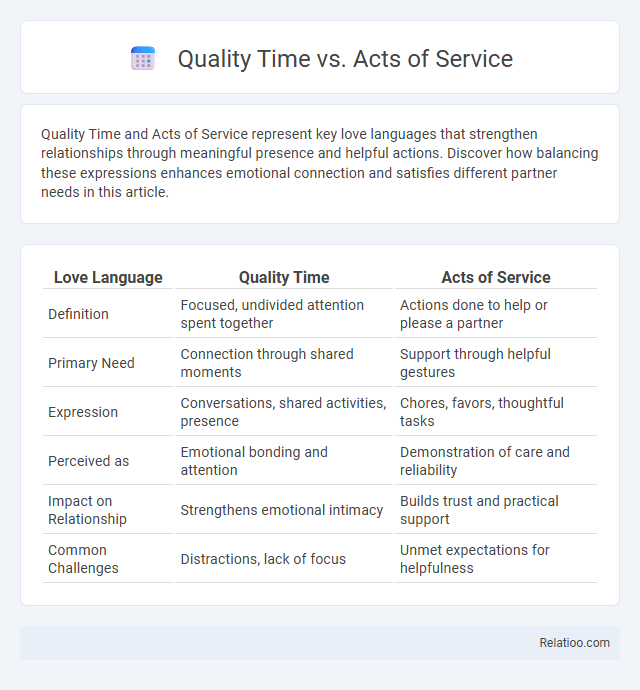Quality Time and Acts of Service represent key love languages that strengthen relationships through meaningful presence and helpful actions. Discover how balancing these expressions enhances emotional connection and satisfies different partner needs in this article.
Table of Comparison
| Love Language | Quality Time | Acts of Service |
|---|---|---|
| Definition | Focused, undivided attention spent together | Actions done to help or please a partner |
| Primary Need | Connection through shared moments | Support through helpful gestures |
| Expression | Conversations, shared activities, presence | Chores, favors, thoughtful tasks |
| Perceived as | Emotional bonding and attention | Demonstration of care and reliability |
| Impact on Relationship | Strengthens emotional intimacy | Builds trust and practical support |
| Common Challenges | Distractions, lack of focus | Unmet expectations for helpfulness |
Understanding the Love Languages: Quality Time vs Acts of Service
Understanding the love languages between Quality Time and Acts of Service helps you tailor your expressions of affection to your partner's preferences. Quality Time emphasizes undivided attention and shared experiences, while Acts of Service involve practical help and thoughtful actions that ease their daily life. Recognizing these differences enables deeper connection and ensures your efforts truly resonate with your loved one's emotional needs.
Defining Quality Time: What It Really Means
Quality Time means dedicating undivided attention to someone, emphasizing meaningful interactions that strengthen emotional bonds. It involves engaging in shared activities or deep conversations without distractions, allowing both parties to feel valued and connected. This form of connection prioritizes presence and active participation, reflecting genuine care and commitment.
Acts of Service: More Than Just Helping Out
Acts of Service demonstrate love through intentional actions that go beyond simple assistance, reflecting care and commitment. These acts, such as preparing meals or running errands, create tangible expressions of support that strengthen relationships. Prioritizing Acts of Service fosters deeper emotional bonds by showcasing reliability and attentiveness in everyday life.
Emotional Impact: How Each Love Language Feels
Quality Time creates a deep emotional connection by making You feel fully present and valued during shared moments. Acts of Service delivers a powerful sense of care and support, showing love through thoughtful actions that ease Your burdens. Each love language evokes unique feelings--Quality Time nurtures intimacy, while Acts of Service fosters reassurance and gratitude.
Communication Styles in Quality Time and Acts of Service
Quality Time communication emphasizes direct, focused interaction, where partners actively listen and share meaningful conversations to strengthen emotional bonds. Acts of Service communication relies on expressing care through helpful actions and practical support, often conveyed non-verbally but understood as expressions of love and commitment. Both styles require awareness of partner preferences to ensure messages of affection and appreciation are effectively received and interpreted.
Common Misunderstandings and Conflicts
Quality Time and Acts of Service are distinct love languages that often lead to misunderstandings when partners prioritize different forms of affection. Individuals valuing Quality Time may feel neglected if their partner expresses love through Acts of Service instead, interpreting the effort as insufficient emotional connection. Conflicts commonly arise from misaligned expectations, where one partner's gestures are overlooked or misinterpreted due to a lack of recognition of the other's preferred love language.
Identifying Your Partner’s Primary Love Language
Identifying your partner's primary love language involves observing how they express affection and respond to various forms of love, such as Quality Time or Acts of Service. Partners valuing Quality Time seek focused, undistracted moments together, enhancing emotional connection through shared experiences. Those with Acts of Service as their primary love language feel deeply loved when their partner performs helpful tasks, reflecting care through practical support and thoughtful gestures.
Practical Ways to Show Quality Time and Acts of Service
Quality time and acts of service represent two powerful love languages that enhance relationship bonds through intentional actions and presence. You can show quality time by dedicating undistracted moments for meaningful conversations, shared activities, or weekend getaways that foster connection and intimacy. Acts of service are demonstrated through thoughtful tasks like cooking a meal, running errands, or helping with household chores, which convey care and support without words.
Balancing Both Love Languages in Relationships
Balancing Quality Time and Acts of Service in relationships enhances emotional connection by addressing diverse expressions of love. Prioritizing intentional presence during shared activities complements thoughtful actions like helping with tasks, fostering mutual appreciation. Couples who integrate both love languages experience increased intimacy and improved communication, strengthening their bond.
Building Stronger Connections Through Love Language Awareness
Understanding the distinctions between Quality Time and Acts of Service enhances Your ability to build stronger connections by recognizing how different love languages express affection. Quality Time focuses on undivided attention and shared moments, while Acts of Service demonstrate care through helpful actions, offering tangible support. Awareness of these love languages allows You to tailor expressions of love, fostering deeper emotional bonds and mutual understanding in relationships.

Infographic: Quality Time vs Acts of Service
 relatioo.com
relatioo.com